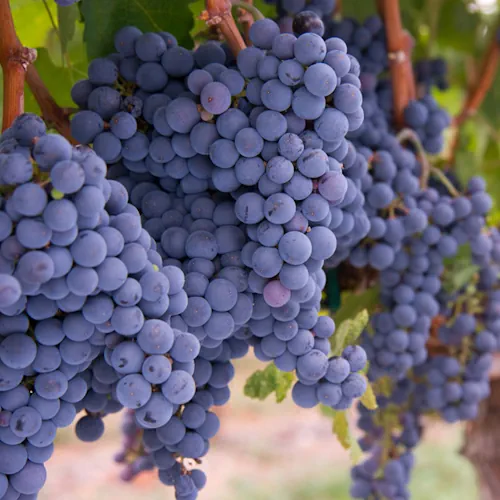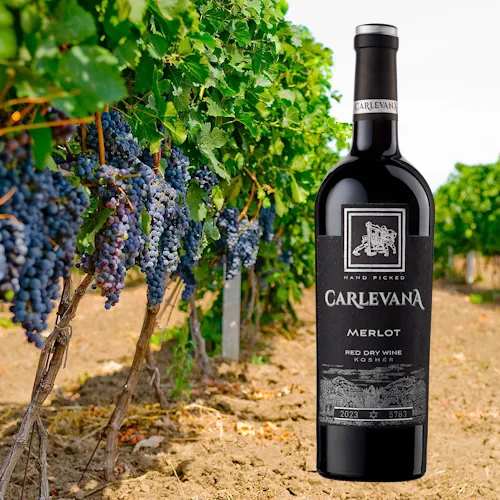Merlot wine: short review

Merlot is one of the most popular grape varieties in the world, used both for single-varietal wines and blends. Thanks to its soft tannins, rich fruit palette, and versatility in production, Merlot wine is appreciated by both beginners and experienced connoisseurs. In this article, we will take a detailed look at the origins of the grape, its key characteristics, major growing regions, and winemaking processes, with a special focus on Moldovan winemaking and Moldovan Merlot wines.
History of Merlot grapes
The origin of Merlot is linked to the French Bordeaux region, where it was first mentioned in the 18th century. The name “Merlot” comes from the French word “merle” (blackbird), possibly due to the dark color of the berries or the birds’ fondness for the grapes.
Genetic research has shown that Merlot is a descendant of Cabernet Franc and the lesser-known Magdeleine Noire des Charentes. Initially, it was used to soften the strict tannins of Cabernet Sauvignon in Bordeaux blends, but over time, it gained popularity as a standalone variety.
Merlot Grapes: characteristics and cultivation

Viticultural features
- Climate and Soil: Thrives best in moderately cool regions on clay-rich and well-drained soils.
- Ripening: Merlot ripens earlier than Cabernet Sauvignon, making it less dependent on weather conditions during harvest.
- Vulnerability: The berries have thin skins, making them susceptible to diseases such as gray rot.
Wine characteristics
- Color: Deep ruby-red, which develops a garnet hue with age.
- Aromas: Ripe berries (black currant, blueberry, raspberry, plum), spicy and chocolate notes, and light vanilla from oak aging.
- Texture and Body: Soft tannins, velvety texture, medium to full body.
Major Winemaking Regions
France
France is the homeland of Merlot, where it is most prevalent in Bordeaux, especially on the Right Bank (Pomerol and Saint-Émilion). Pomerol produces some of the best Merlot wines in the world, such as the legendary Château Pétrus.
Italy
In Tuscany, Merlot is often used in the famous “Super Tuscans,” such as Masseto, produced by the Ornellaia winery.
USA
California Merlot, especially from Napa Valley, is known for its richness, high fruitiness, and pronounced oak notes.
Chile
Chilean Merlot often exhibits bright fruit aromas, soft tannins, and affordability, making it popular on the global market.
Moldova: winemaking traditions

Moldova is one of the oldest winemaking regions in Europe, and Merlot plays a significant role here. The favorable climate and fertile soils create ideal conditions for cultivating this variety. Moldavian wine Merlot has a rich and intense bouquet.
Features of Moldovan Merlot
- Expressive fruit and spicy notes: Black cherry, plum, light chocolate undertones.
- Aging: Oak is often used, adding depth and complexity to the wine.
Famous Moldovan Merlot wines
- Merlotage Raritet is an iconic wine where Merlot combines with Cabernet Sauvignon and Malbec to create a powerful, structured flavor.
- Merlot kosher wine – an exquisite wine made according to all kashrut rules.
- Merlo Renessance is a mono-varietal wine with a velvety texture and notes of black fruits and spices.
How to Choose and Pair Merlot
Choosing a Wine
- For everyday drinking: Young, fruity Merlots, such as Chilean or Moldovan.
- For special occasions: Aged French and Italian examples with deep flavor and complex aromas.
Food Pairing
- Red Meat: Steaks, duck, lamb.
- Cheeses: Soft varieties like Brie or Camembert.
- Vegetable Dishes: Roasted eggplant, mushrooms.
Merlot is a versatile grape variety, appreciated for its softness, rich aroma, and diverse styles. Moldovan winemaking, in particular, produces high-quality wines that combine tradition and modern techniques. Regardless of preference, there is always a Merlot wine to suit every taste and budget.
Wine from Carlevana Winery, created with love! You can buy our wine in the wine store in Chisinau – come, you won’t regret it.

